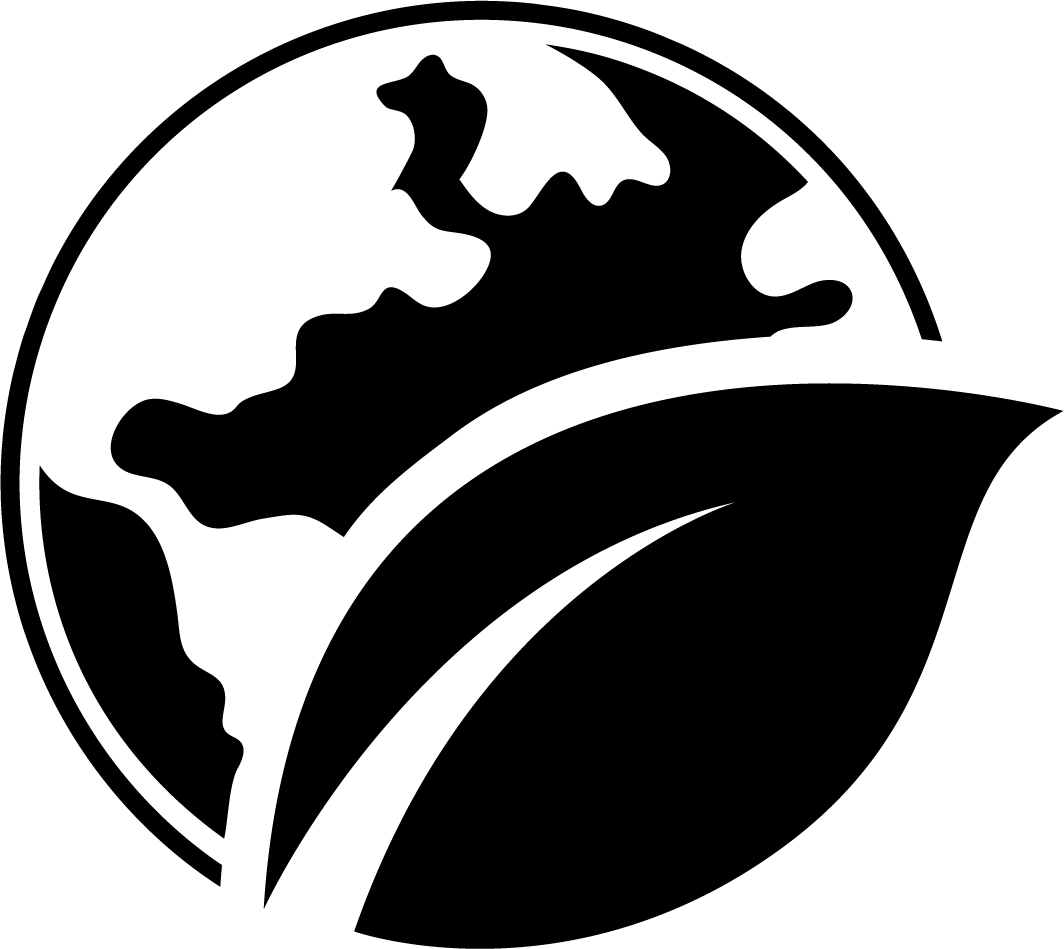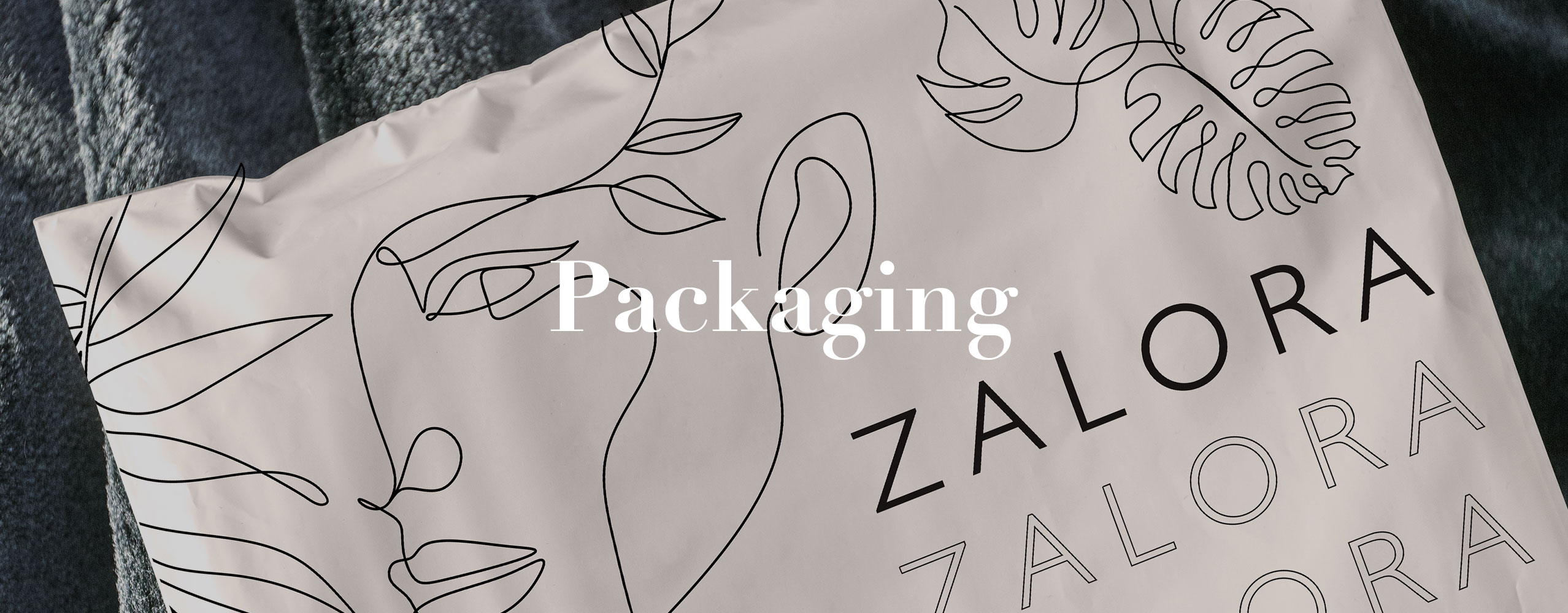
This is an even greater priority that the environmental impact of packaging is the top sustainability issue of concern for our customers, in markets where we know that they do not always have access to waste sorting and recycling facilities
ZALORA's plastic delivery flyers are our first visible impact facing customers, which we prioritized in 2020 by transitioning the flyer composition to a more sustainable material, choosing to use recycled plastic materials rather than virgin plastic
Operations teams have been working for several months in 2020 to develop a more sustainable alternative to the current plastic flyer packaging used across all countries to deliver our customers, by identifying a local Malaysian-based packaging vendor able to supply pre-consumer waste recycled plastic. Without compromising on our quality, cost and logistic requirements, we have been able to transition all plastic flyers delivering Malaysia, Singapore, Hong Kong and Taiwan customers to 80% of recycled plastic content. Our other Operations countries, Indonesia and Philippines, will also roll-out this solution early 2021.
This initiative both reduces significantly the overall environmental impact of our delivery flyers while nurturing a demand for such alternative materials in a country where the waste recycling industry and use of recycled material is at an early stage.
If there is no difference between recycled and virgin plastic, how can I know this packaging is really made of recycled material ?As transparency is one of our core commitments, we collaborated with our packaging vendor to engage them in a certification process through the Recycled Content Standard (see website). This third party certification provides ZALORA and its customers the insurance of the recycled content by verifying the traceability of the material along the supply chain. We are very thankful that our packaging vendor joined us into this sustainability journey, and proud of their certification achievement that also illustrates our commitment to shape our sustainable ecosystem, bringing along our key partners.
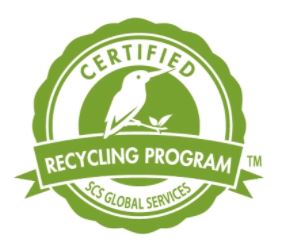
We are now focusing our efforts to transition cardboard, representing 70% of our Operations packaging, to more sustainable materials. To address ZALORA’s impact across all our supply chain, we do not only focus on our Operations, but we also work collaboratively with our Private Labels brands’ vendors to replace polybags, the transparent plastic protection used to ship every single item, to 100% of pre-consumer recycled plastic. As of now, most of our Private Label vendors have transitioned to this new packaging, and we will expand our eco-design efforts next year to cardboard shipping boxes and hand tags.
When we are striving to give you the best shopping experience with Zalora, we also recognize the needs to reduce the impacts to the planet and society, which includes helping you to find the best end of life for your packaging waste !

Through our collective efforts, we can :
- Reduce the overall amount of waste produced
- Extend the lifecycle of materials which can be reused, repurposed or recycled, and support circular economy.
Every little green step counts! Let's recycle right and make a difference now !
Let's dig into waste management challenges in Singapore to understand why we need to reduce our waste at source and recycle right.
What's the current situation?
Singapore is increasing the amount of solid waste over the years, and running out of landfill space.
in 2019 :
- 7.23 million tonnes of solid waste was generated in 2019.
- 73% of non-domestic waste (industrial, construction, etc.) was recycled, but only 17% of domestic waste was recycled!
- 4% of plastic waste only was recycled...
Waste that isn't recycled is sent to one the solid waste disposal infrastructure : four waste-to-energy plants (Tuas, Senoko, Tuas South and Keppel Seghers Tuas), and one landfill facility (Semakau Landfill).
The amount of waste disposed of has increased seven-fold over the last 40 years. At this rate, Singapore's only landfill, will run out of space by 2035.
So we need to recycle more by better segregating our domestic waste !
Indeed, despite all recycling efforts, approximately 40% of what is thrown into the blue recycling bins is wrongly segregated and are contaminants, i.e they can not be recycled and will eventually be sent to incineration plants.
Singapore has set a national recycling rate target of 70% in 2030, with an increase in domestic recycling rate to 30%. This can only be achieved through the involvement from all stakeholders, including each of us! To support this collective effort, Singapore has set a Zero Waste Masterplan to enhance its waste collection and management system and practices to reduce the waste generation and increase recycling rate. Visit the website to know more !
NEA’s National Recycling Programme ensures every HDB estate, private estate and landed properties have access to recycling bins and recycling collection services. Public housing developments, which are launched after 2014, have dual chutes for refuse and recyclables on each floor.
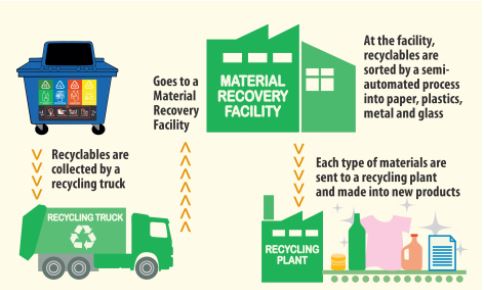
WHAT CAN YOU DO?
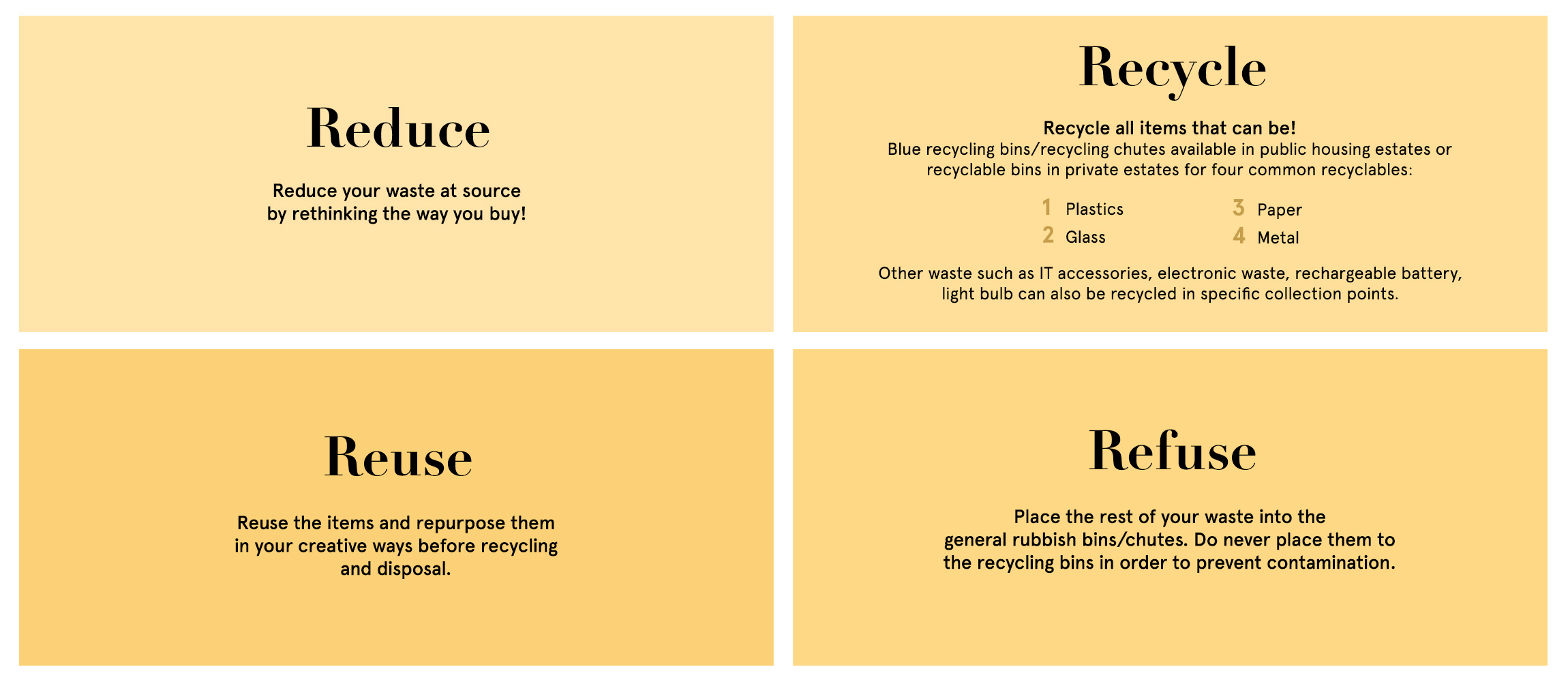
If you are not sure about what should be placed in the blue bins for recycling, and what should not? click here to check the full list of recyclables and non recyclables.
Other waste such as IT accessories,Electronic waste, Rechargeable battery,Light bulb , Look at the list here to find the most convenient place to recycle your waste !
OUR ZALORA PACKAGING - WHAT CAN YOU RECYCLE?
Most of ZALORA’s packaging is recyclable !
What can you place in the blue bin for recycling ?
|
|
| What cannot be recycled and must be placed in the general trash : Wax paper, thermal stickers, labels, polystyrene foam, string, etc. |
Let's dig into waste management challenges in Taiwan to understand why we need to reduce our waste at source and recycle right.
What's the current situation?
Taiwan is increasing the amount of solid waste over the years.
- Per capita disposal rate of municipal solid waste has increased from 0.915kg/person/day in 2017 to 1.14kg/person/day in 2019.
- About 9.81 million tonnes of solid waste was generated in 2019. Overall, the recycling rate was 56% in 2019 which decreased from 60% in 2017.
Waste that isn’t recycled is sent to waste-to-energy incineration plants or disposed of at landfills, with the guideline amining on “incineration first; landfill as the alternative”. There are more than 20 incineration plants across the country. Incinerations are a good alternative to landfill when allowing to produce energy out of waste. But these facilities remains polluting, and recycling should be promoting over any other type of waste treatment.
Not every county is equipped with equivalent waste management facilities and resources. Some counties, due to the lack of incineration plants, may need to transport the garbage to other counties for incineration. Massive amounts of trash piled up for incineration may cause some environmental concerns, such as land and water contamination.
Together with the "Keep Trash Off the Ground" policy, the EPA has introduced different measures to reduce waste generation and to increase the recycling rate, including volume-based waste fee system, mandatory waste separation and mandatory food waste recovery. With a vision of circular economy, the EPA has adopted a sustainable materials management approach to work towards full material recycling and zero waste by 2050. This can only be achieved through the involvement from all stakeholders, including each of us! Visit the website to know more !
WHAT CAN YOU DO?
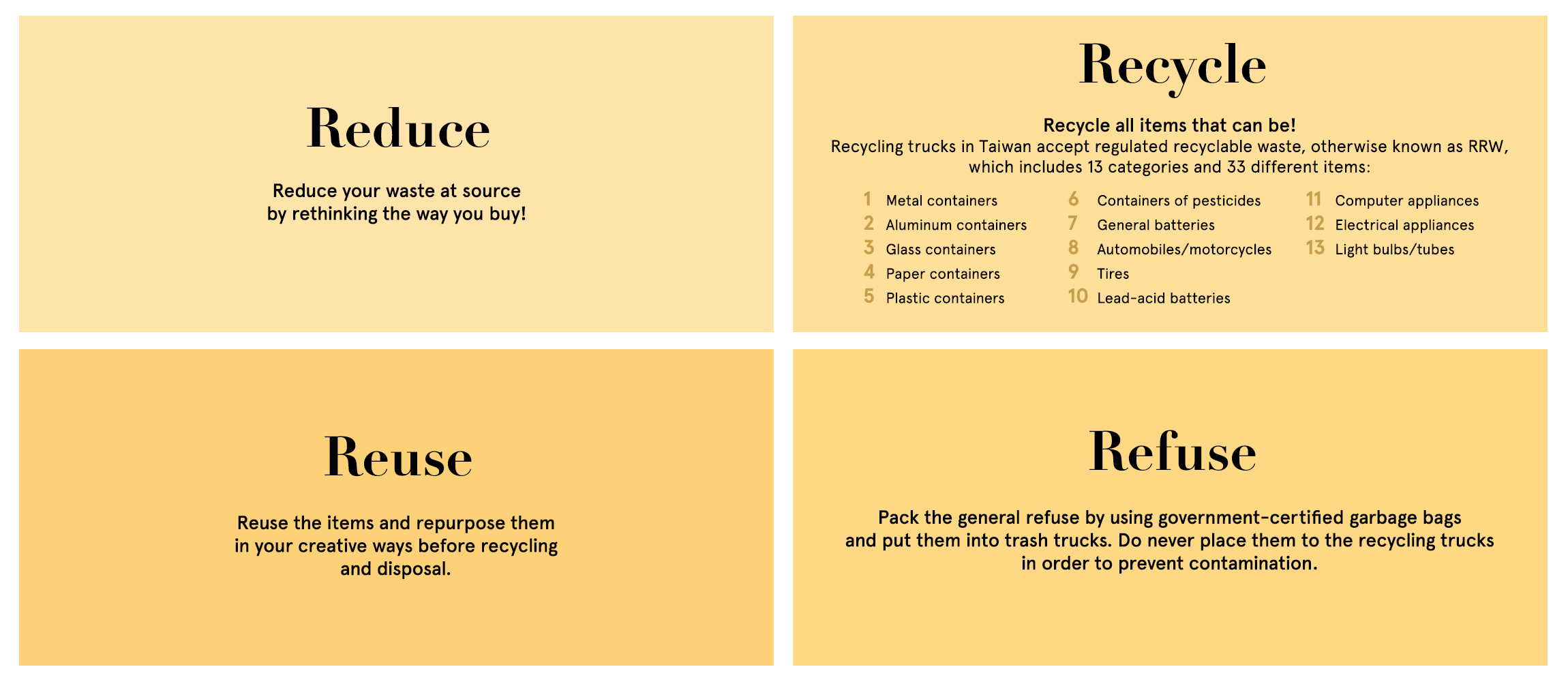
You are not sure about what should be placed in the recycling truck, and what should not? Click here to check the full list of recyclables and non recyclables.
OUR ZALORA PACKAGING - WHAT CAN YOU RECYCLE?
Most of ZALORA’s packaging is recyclable !
What can you place in the recycling trucks?
|
|
| What you cannot recycle and must place in the trash trucks: Wax paper, thermal stickers, labels, strings etc. |
any Any doubt ? Click here to find the list of recyclables and non recyclables.
Let’s dig into waste management challenges in Hong Kong to understand why we need to reduce our waste at source and recycle right.
What's the current situation?
Hong Kong is increasing the amount of solid waste over the years and running out of landfill space. In 2018:
- 1.53kg/person/day of municipal solid waste was produced, representing +15% compared to 2011.
- 5.95 million tonnes of municipal solid waste was generated.
- of domestic waste only was recycled, which is lower than the 39% recycling rate for commercial & 4% of plastic waste only was recycled.
Waste that isn't recycled is disposed off at landfills. Three strategic landfills are West New Territories (WENT) Landfill, South East New Territories (SENT) Landfill and North East New Territories (NENT) Landfill. The Integrated Waste Management Facilities (IWMF) with that will introduce the incineration technology is still under construction and is expected to be commissioned by 2025.
With increasing amounts of waste generated over the years, the three strategic landfills are running out of space and the EPD has to extend the landfills to meet Hong Kong’s waste needs until the 2030s. In space-scarce Hong Kong, can we afford to devote more lands to rubbish?
Hong Kong has set a target to increase recycling rate to 55% and reduce the current per capita municipal solid waste disposal rate to 0.8kg/person/day by 2022. This can only be achieved through the involvement from all stakeholders, including each of us!
To support this collective effort, Hong Kong has set a Hong Kong: Blueprint for Sustainable Use of Resources 2013-2022 to enhance its waste collection and management system and practices to reduce the waste generation and increase recycling rate. Click here to know more !
WHAT CAN YOU DO?
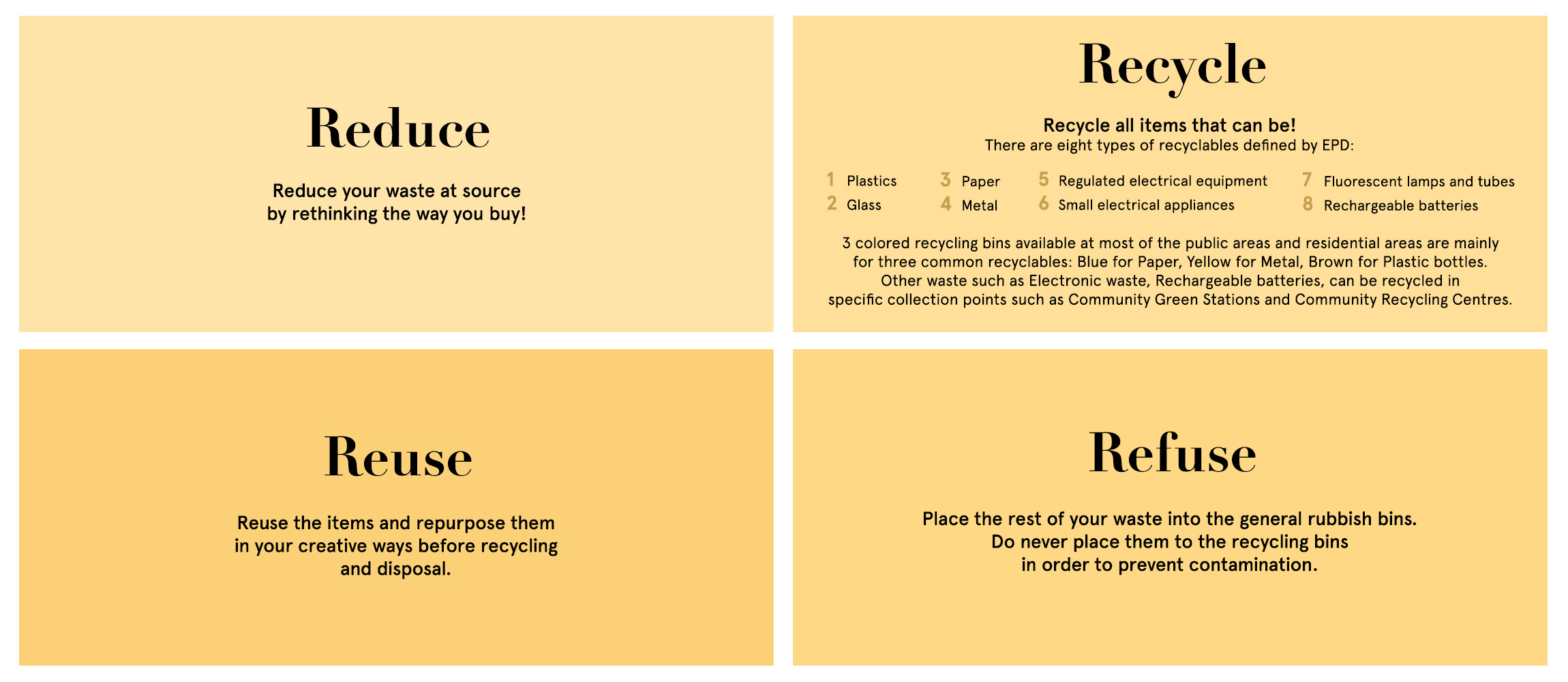
For more information, Look at the list here to find the most convenient place to recycle your waste !
OUR ZALORA PACKAGING - WHAT CAN YOU RECYCLE?
Most of ZALORA’s packaging is recyclable !
What can you place in the 3 colored recycling bins?
What can you place in other specific collection points ( such as Community Green Stations) ?
|
|
| What cannot be recycled must be placed in the general rubbish bins: Wax paper, thermal stickers, labels, strings etc. |
any Any doubt ? Click here to find the list of what and where to recycle.

